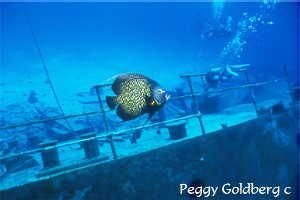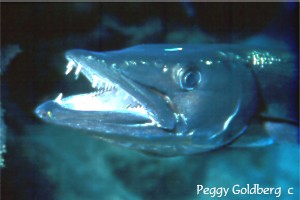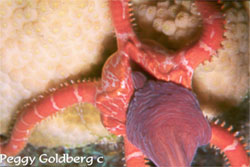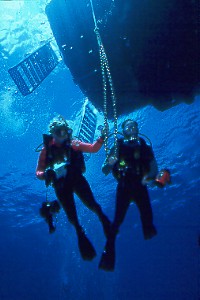|
|
 |
Bracketing
and Patience |
|
|

|
|
Angelfish in 3-D
Taken with a Nikonos IV / 16mm lens at f8
- strobe on 1/2 power at less than 2' from
angelfish
|
Unlike land
photography, we are very limited in the time we have to take
the picture...not only due to depth and air constraints, but
our subjects are constantly moving, and we have
nanoseconds to determine exposures, composition and
distances for focusing and strobe lighting. We don't have the
luxury of taking "in house dupes" (taking several of the
same photos for duplicates) unless you are photographing
invertebrates, or objects that do not move.
Unfortunately, we tend to go brain dead underwater and forget
how to operate that object we hold in our hands! So, you still
want to try it?
One of the mistakes that is common to
beginning photographers is that they swim up quickly to
a subject, take the picture, and swim on to another subject.
In order to get consistently good shots, you must take as many
pictures as you can at that time. You will be amazed
that you can take 6 shots of your subject, yet only one
(or none!) will come out as you'd hoped.
| Underwater
photography is very unique in many ways -other then the fact you
are doing it underwater! Last time, we touched upon the subject of
types of cameras, how important our buoyancy control is
underwater, and how, unlike land photography, we must get
very close to our subjects and look up toward the light.
|

|
|
Barracuda
with cleaner Blennies
Taken with Nikon 90 in Nexus
housing - 60mm lens at f11, strobe on TTL Approaching
slowly, this 6' barracuda allowed me within 4' of it
while it was being cleaned! |
|
Backscatter, caused by particles in the
water lit up by your strobe, poor composition (cutting
off the fishes tails, for instance), out of focus, over and
underexposing, choosing the wrong speed, are but a few of the
things that can go wrong - causing you to smack your head and
go "Doh!" Often, it's not as if we can just go back out and
try again, like you might with land photography.
You need
to try to get the picture by changing strobe positions,
bracketing by changing exposures one or more stops, and
experiment.....once you really know your camera, film, and
whether or not your strobe is putting out the kind of
light you need for the apertures you are selecting, you will
start to get consistently better shots.
Expect in the
beginning to get about 2-3 "keepers" in a roll. Later on,
you should have a major part of the roll as
acceptable...maybe not great, but, at least in focus,
well composed, and fairly well exposed.
By now you
have probably guessed underwater photography consists of
a lot of hanging or laying around in one spot....you are
pretty much right. First, you can't see things if you
are finning like mad, trying for distance on the reef. You
will also scare away most marine life. Second, part of
the secret of getting good shots is to know your subjects -
and how can you do that if you don't take the time to observe
their behavior and get to know them?
I am often asked,
when I do my slide programs , is "How did you find that? And
how do you know what it is?" The answer to that question is -"
An underwater photographer has to be better than a hunter, and
be non-threatening- a part of the reef and its inhabitants.
You will spend a lot of time looking at your pictures,
going to libraries, talking to biologists, and reading about
behaviors. And sometimes, you will have the pleasant surprise
to photograph something that no one else has seen or yet
identified. I have found three unidentified creatures in the
last 3 years!
So, take a deep breath, relax, and
concentrate on getting to know what your camera can do
under different lighting conditions. Learn when to stalk
your subject, and when to wait for them to come to
you.
Read every fish/coral/marine creature ID, and marine
behavior book you can find, and you will find you are getting
more keepers and surprises on that roll.
|
|

|
Unidentified worm
eating a Ruby Brittlestar.
Taken with a
Nikonos V with a closeup lens - f22- strobe on TTL Found on one of
the most dived places in the world - The Aquarium in Grand Cayman at
night! This purple worm was over 6' long, and very sensitive to
light - the other end went under a coral head. Has so far eluded
definite identification.
|
|



